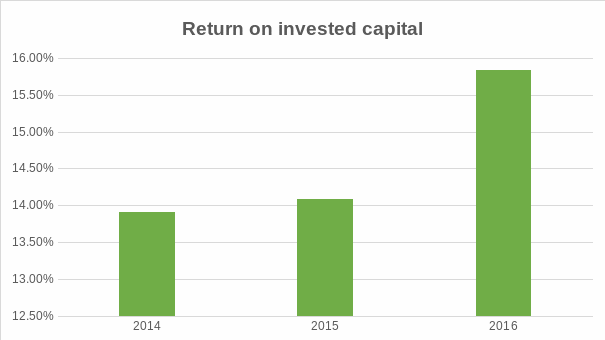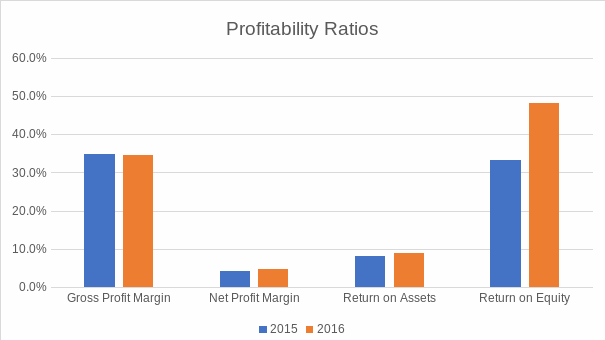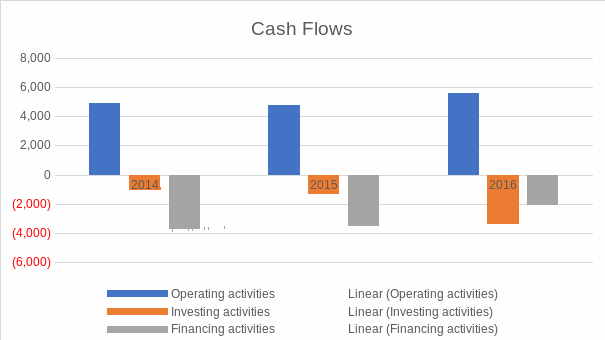Abstract
Lowe’s Company has a strong market position, which assists it to generate higher sales every year. However, it is important to evaluate whether the company is generating enough profitability and cash to ensure that its competitive advantage can be maintained in the coming periods. In this paper, the company’s Return on Invested Capital and other profitability ratios are calculated and analyzed for the last three years. Moreover, the company’s cash flow statements are evaluated to determine the firm’s cash-generating ability. The results indicate that the company has a strong, profitable position. Moreover, its cash flows from operating, investing, and financing activities increased in the last three years. It is concluded that the company is unlikely to face any major financial problem.
Introduction
In the previous analysis part, balance sheets of Lowe’s Company (Lowe’s) were analyzed for the last three years, which indicated that the company’s net book value increased in 2016. Moreover, the company reported an increase in its earnings in 2016 (Lowe’s, 2017). It would be interesting to investigate the company’s cash flows especially operating cash flow and the company’s profitability during 2014-16 to assess its position.
Return on Invested Capital
The company’s profitability is assessed by calculating the return on invested capital ratio. The ratio indicates the effectiveness of a business to earn profits from its investment (Bodmer, 2014; Procházka, 2016). The return on invested capital of Lowe’s increased by 0.18 percent in 2015. The main reason for the improvement in the ratio value was the sales growth of home improvement products and appliances in 2014.
Further improvement in the ratio value was noticed in 2015 due to the substantial increase in net earnings. The persistent increase was followed by the increasing demand for home improvement products fueled by the increasing demand for new homes and renovations. Additionally, Lowe’s succeeded in controlling its capital expenditure in the last three years and focused more on increasing sales per square foot in its existing stores that increased its net earnings.
Table 1: Return on Invested Capital.
The consistent growth in the ratio value can be noted in Figure 1, which indicates that Lowe’s managed to increase its profitability by utilizing its available resources. Lowe’s effective tax rate also declined in the last three years that had a positive impact on net earnings.

Additional Profitability Ratios
Profitability ratios are used to measure the potential of a business to generate more income in the coming periods (Goel, 2015). The values of the gross profit margin provided in Table 2 indicate that Lowe’s was inefficient to control its cost of sales. Lowe’s incurred high labor costs for production due to the increased competition in the global market. However, the company was efficient in reducing its revenue expenditures as compared to its sales.
Lowe’s reduced its amortization and depreciation expense by selling some of its non-performing operating assets (Lowe’s, 2017). On the other hand, the acquisition of new assets proved to be beneficial in 2016 as indicated by the improvement in the value of return on assets of the company. The return on equity of Lowe’s significantly increased in 2016. The main reason was the decline in the retained earnings of the company despite an increase in its earnings.
Table 2: Profitability Ratios.
As shown in Figure 1, the profitability ratio trend indicated that Lowe’s showed a slight improvement in the values of net profit margin and return on assets in 2016. It indicated the company’s weakness in controlling and managing its costs. However, the company maintained consistency in generating a high profit by utilizing its available assets.
The following figure graphically represents changes in profitability ratios discussed above.

Cash Flow Statement Analysis
The cash flow statement shows total cash inflows and outflows of a business in the financial period (Robinson, Henry, Pirie, Broihahn, & Cope, 2015; Wahlen, Baginski, & Bradshaw, 2017). The cash flow analysis of Lowe’s showed a positive trend in net cash flows from operations in the last three years. It was due to the increase in net operating assets. On the other hand, the company’s net operating liabilities decreased. Lowe’s sold its non-performing assets to reduce the financial burden and acquired new assets to generate a high income. The consistent improvement showed that Lowe’s succeeded in managing its financial position in 2016.
A similar trend was noticed in net cash generated from investing activities as Lowe’s made new investments in its existing network to generate a higher profit and reduced capital expenditures by limiting the number of new stores in different cities. The management decision proved to be beneficial because Lowe’s profitability position improved in 2016 due to the company purchased securities. Lowe’s also borrowed an amount from finance providers to manage its long-term investments.
The main reason for borrowing was to arrange additional cash that could be utilized to fulfill the obligations of the company within the specified time. The net cash and cash equivalents at the end of 2016 indicated that Lowe’s reported a positive change in its cash position, which is important to reduce the risk of solvency.
Table 3: Cash Flow Statements.
Figure 2 indicates changes in the cash flows from operating, investing, and financing activities in the last three years along with the trend lines for them. The trend lines also show that the company was able to improve its cash flows in three years. However, the main concern discussed earlier is that the company depended on the proceeds from long-term borrowing to compensate for the gap between inflows and outflows. Moreover, it could be indicated that the company benefited from its recent acquisition that is expected to improve its position in the market and generate more income.

References
Bodmer, E. (2014). Corporate and project finance modeling: Theory and practice. Hoboken, NJ: John Wiley & Sons.
Goel, S. (2015). Financial ratios. New York, NY: Business Expert Press.
Lowe’s annual report 2016. (2017). Web.
Procházka, D. (2016). New trends in finance and accounting: Proceedings of the 17th annual conference on finance and accounting. New York, NY: Springer.
Robinson, T. R., Henry, E., Pirie, W. L., Broihahn, M. A., & Cope, A. T. (2015). International financial statement analysis, Third Edition (CFA Institute investment series). Hoboken, NJ: John Wiley & Sons.
Wahlen, J., Baginski, S., & Bradshaw, M. (2017). Financial reporting, financial statement analysis and valuation. Mason, OH: Cengage Learning.